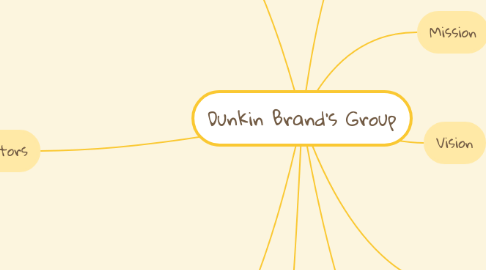
1. Market segments
1.1. Dunkin 'Brands operates in four segments Dunkin Donuts U.S and International and Baskin Robbins U.S and International
1.1.1. 1)
1.1.1.1. Dunkin Donuts
1.1.1.1.1. The Dunkin ’Donuts brand has evolved into a predominantly coffee-based concept, with Approximately 57 percent of sales reported by Dunkin’ Donuts franchises in the US and the remaining percentage in international markets.
1.1.2. 2)
1.1.2.1. Baskin Robbins
1.1.2.1.1. About 65 percent of Baskin-Robbins restaurants are located outside of the United States. and they operate mainly through joint ventures and national or territorial licensing agreements with "Master franchisees". The Baskin-Robbins international franchise system, predominantly located in Asia and the Middle East
2. Competitors
2.1. Dunkin 'Brands Group's main competitors are Krispy Kreme Donuts (KKD), Starbucks and Tim Hortons (now owned by Restaurant Brands) are dominant rivals and sales of coffee and donuts have been increasing annually.
2.1.1. Starbucks Corporation: Starbucks is the world's largest specialty coffee retailer with more than 18,000 coffee shops in 60 countries. Offers coffee drinks and cakes, roasted beans, coffee accessories and teas. The company owns about 9,400 of its own stores (primarily in the United States), while licensees and franchisees operate approximately 8,650 units worldwide (primarily in shopping malls and airports).
2.1.1.1. Krispy Kreme Donuts: is a chain of donut establishments with approximately 695 locations throughout the United States and in about 20 other countries. The stores are popular for their glazed donuts that are served hot and fresh from the air fryer, as well as filled cakes and donuts, fritters and fritters. Hot coffee and other drinks are also sold. Almost all KKD outlets are owned and operated by franchisees; the company owns and operates 90 locations
2.1.1.2. Tim Hortons is Canada's leading quick-service restaurant brand, with more than 4,250 coffee shops and donut shops across the country and in multiple US states. Tim Hortons was acquired by Burger King Worldwide in late 2014 in a $ 11 billion deal, and BKW immediately created Restaurant Brands International (RBI). RBI is now the second largest global fast service restaurant in the world.
